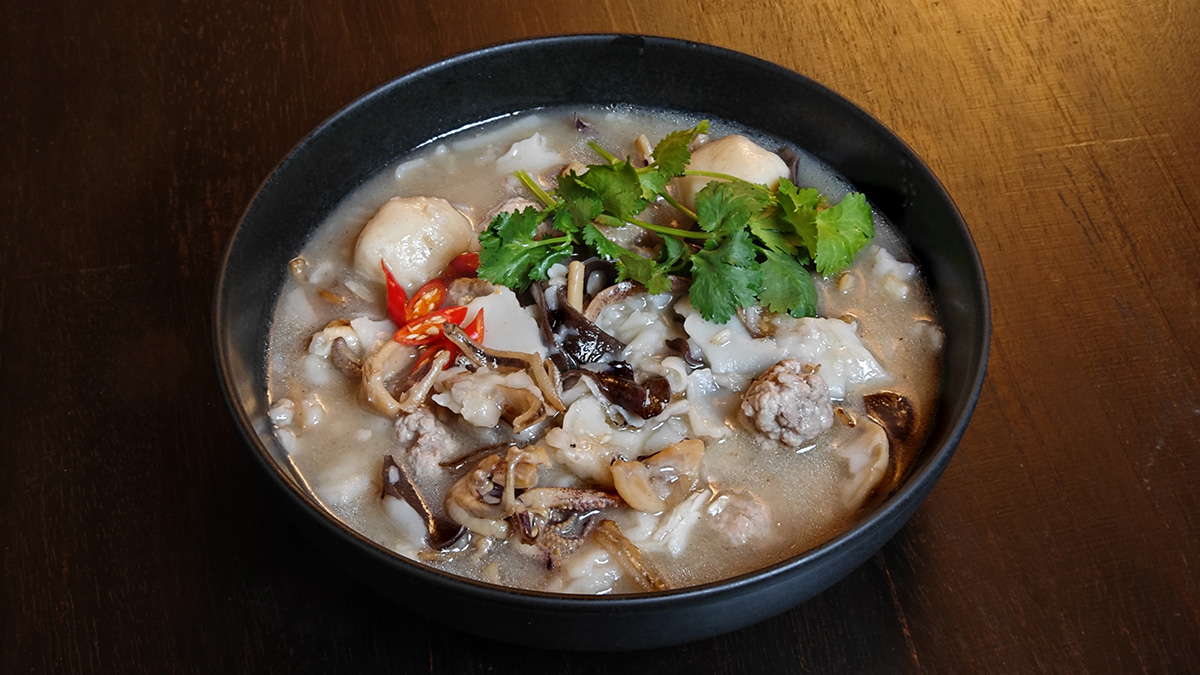Clem's
Ding Bian Hu
Ding Bian Hu (I have spelt it in the manner commonly seen in Sarawak) is a Foochow (Fuzhou) dish from the Fujian Province in Southern China. For those who may be interested in how it is referred to in Mandarin, it is Diāng-biĕng-gù (simplified Chinese: 鼎边糊; traditional Chinese: 鼎邊糊; literally 'pot side paste', Foochow Romanized: diāng-biĕng-gù). In this dish, to a savoury soup with meat and seafood is added rice batter flakes which is cooked by spreading rice flour batter onto the side of the wok being used to cook the soup (hence: "pot side paste").
It is rather strange that I never came across this dish in Sarawak (Kuching and Sibu) until 2008 when Simon Yeo (a classmate from primary school) introduced it to me at a food court. I have liked the dish ever since but never cooked it from scratch until tonight. It is relatively easy to prepare this dish. Here's how:
INGREDIENTS
For one serving (quantities vary according to one's wishes; omit ingredients not to your fancy e.g. make a halal version using chicken and fish):
The soup
- Dried anchovies.
- Dried squid or
cuttlefish.
You may wish to use fresh squid/cuttlefish but the dried product has a distinct taste.
- Dried lily
flowers/buds (Hemerocallis fulva).
- Dried Chinese Black
mushroom (often labelled as Black Fungus).
- Fishballs.
- Minced pork formed
into balls.
- Minced garlic.
- Coriander leaves or
sliced spring onion (for garnish).
The rice batter flakes
- 100 g rice flour (depends on your appetite).
METHOD
Prepare the dried
ingredients
- Soak the anchovies,
squid/cuttlefish, Black Mushroom and lily flowers in water
for a couple of hours.
Note (1) You may want to soak the anchovies for a short time only, just to soften them a bit. Over-soaking will remove their umami.
Note (2) For the squid/cuttlefish, you may wish to rehydrate them back to near original tissue softness by soaking them in alkaline water. To make water alkaline, add some sodium carbonate to it. You can buy sodium carbonate in Chinese groceries or make it yourself by heating baking powder (sodium bicarbonate) spread in a thin layer in an oven (150oC for one hour). How much you rehydrate the dried squid/cuttlefish is a matter of preference but be aware that dried cephalopods can be very chewy.
- After soaking,
Slice the mushroom into strips.
Slice the squid/cuttlefish into slices of width commensurate with their tenderness.
- Squeeze all the
water out from the soaking lily flowers.
Prepare the rice batter
- Mix the rice flour
with an equal volume of cold water.
- Check its
consistency after stirring the slurry very well.
The slurry should be runny (at the point where when pouring, the stream wants to break into drops).
Adjust the slurry as necessary to thicken or water down by adding rice flour or water as appropriate.
- Set aside for later use.
Now you are ready to
cook.
Cooking
- You will need to
use a wok or saucepan with enough gently sloping wall area
onto which rice batter can be poured to cook while also
holding the soup.
Otherwise, you can follow the instructions for making the rice batter flakes while using a completely different cooking pan from the soup.
- Heat up cooking oil
and add the minced garlic.
- As soon as you can
smell garlic fragrance, add the anchovies, squid/cuttlefish,
and fishballs.
- Fry all until
fragrant and then add the mushroom.
- After a couple of
minutes, you can add boiling water to the fry to make up
soup volume.
- Now add the pork
balls and continue boiling to cook them.
- Now you can add the
lily flowers.
- Stir the rice flour
batter very well.
With your cooking heat set on high (the wall of the wok need to be hot), start pouring the rice batter onto the side of the wok holding the soup.
Let a thin layer of the batter coat the wall of the wok above the boiling soup (do not let the batter fall directly into the soup).
To help the batter cook, you may choose to cover the wok with a lid.
- When the batter has
set, use a spatula to scrape large flakes of it off the wok
wall into the soup.
Boil for a bit more to ensure that the rice flakes are well cooked.
- Check the soup
again for consistency.
It may have thicken due to rice flour additions.
Thus, you can adjust the soup with boiling water if appropriate.
Taste, and add any condiments of your liking to the soup.
- Ladle out and
garnish with coriander leaves, or spring onions (fresh or
fried).
- Now you have made
Ding Bian Hu.

Clem's Ding Bian Hu
All my cooking (some without recipes) can be found here (click on each photo to go to that dish's page):
http://clemkuek.com/photoalbum/photo696.html
Video presentations can be found here:
Earlier days: https://youtu.be/BWyHY1h9Y5s
More recently: https://youtu.be/cph2XmwuQLU
01 February
2025
Created by Clem Kuek
